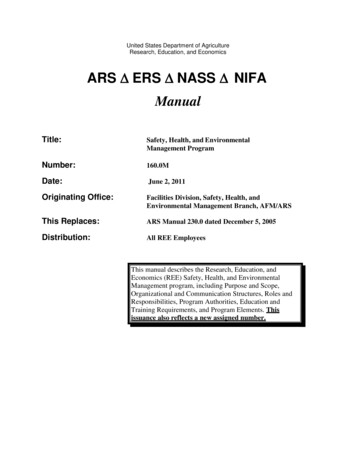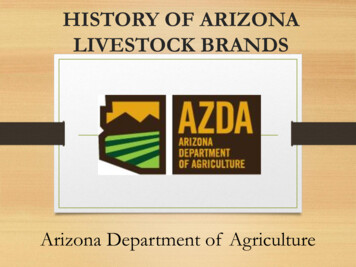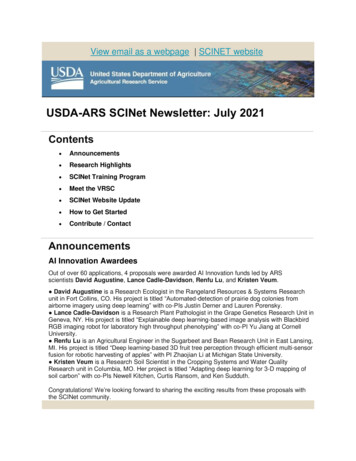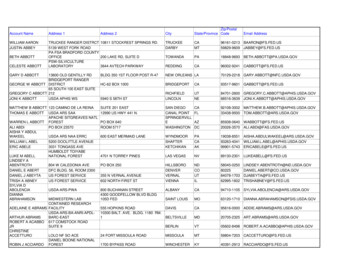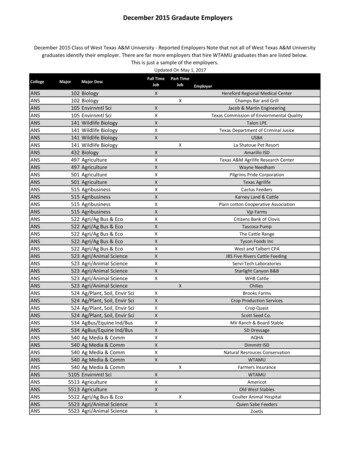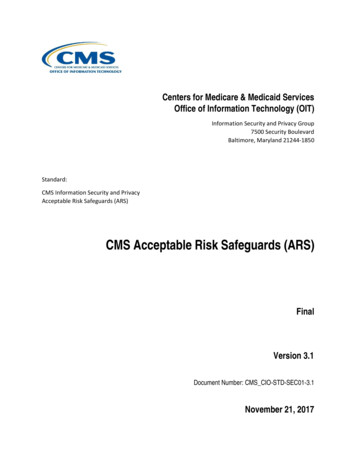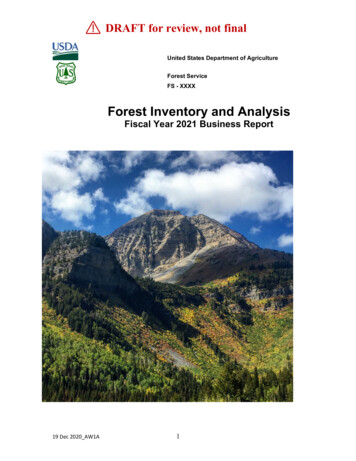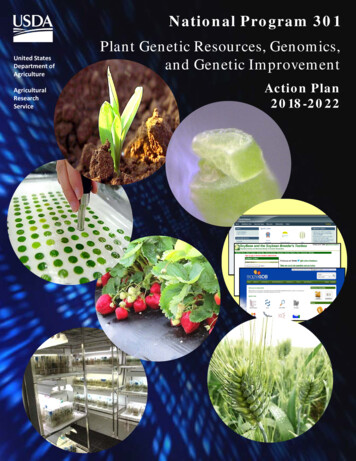
Transcription
National Program 301United StatesDepartment ofAgricultureAgriculturalResearchServicePlant Genetic Resources, Genomics,and Genetic ImprovementAction Plan2018-2022
USDA - AGRICULTURAL RESEARCH SERVICENational Program 301PLANT GENETIC RESOURCES, GENOMICS, AND GENETIC IMPROVEMENTAction Plan 2018-2022MissionTo harness the genetic potential of plants to transform U.S. agriculture.VisionTo be a global leader in research in plant genetic resources, genomics, and geneticimprovement by providing knowledge, technologies, and products to deliver high crop yieldsand product quality, reduce global food insecurity, and decrease the vulnerability of globalagriculture to destructive diseases, pests, and environmental extremes.IntroductionCrop plants underpin U.S. agriculture and food security. Increased crop yield, product quality,and production efficiency are required to safeguard the Nation’s agricultural economy and foodsupply. This national program addresses the preceding critical needs for increased cropproductivity by providing crop plants with higher inherent genetic potential. To do so requirescontinuous crop genetic improvement through more efficient and effective plant breeding,which exploits sources of new genes and traits from the Nation’s genebanks, leading-edgebreeding methods, data-mining, bioinformatic tools, and incisive knowledge of crop molecularand biological processes. ARS breeders, plant scientists, computational biologists,programmers, and many others are engaged in a global quest to transform and accelerate thepace of innovation in plant breeding and crop production.USDA Agricultural Research Service (ARS) places a high priority on realizing the products andaccomplishments described in this National Program (NP) 301 Plant Genetic Resources,Genomics, and Genetic Improvement Action Plan 2018-2022, recognizing that without NP 301,“the risk and vulnerability to U.S. and world agriculture would be substantial.” 1 NP 301advances the ARS goals to protect, expand, and enhance the crop genetic resource base of theUnited States; increase scientific knowledge of crop genes, genomes, biological processes andsystems; and deliver economically and environmentally sound technologies that improve theproduction efficiency, quality, health, and value of the Nation’s crops. At the core of its focus,ARS research in NP 301 will harness the genetic potential of plants and translate that potentialinto crop products that generate economic gain and consumer benefits. This National Programwill contribute strongly to meeting the anticipated global demands for food, feed, fiber and1Quotation taken from the NP 301 Retrospective Review (June 27-28, 2016) Panel presentation
USDA-ARS NATIONAL PROGRAM 301 ACTION PLAN [2018-2022]renewable energy and to meeting the USDA-ARS Grand Challenge to “Transform agriculture todeliver a 20% increase in quality food availability at 20% lower environmental impact by 2025.”This National Program will develop, and effectively apply, new knowledge of crop genes,genomes, and the control and expression of genes, to accelerate the rate of geneticimprovement and product quality improvement through traditional and novel plant breedingmethods. Through innovative research tools and approaches, this National Program willmanage, integrate, and deliver vast amounts of raw genetic materials (genetic resources);superior cultivars; and genetic, molecular, biological, and phenotypic information to a diverseglobal clientele. The ultimate goals for these efforts are to improve the production efficiency,yield, sustainability, resilience, healthfulness, product quality, and value of U.S. crops.More specifically this National Program addresses the needs to: Ensure the long-term availability and integrity of the Nation’s plant and microbialgenetic resource collections and associated information by safeguarding them in stateof-the art genebanks; Identify and fill gaps in plant and microbial genebank collections, and acquire,characterize, and deliver high quality genetic and information resources to researchers,breeders, producers, and consumers; Devise new methods to accelerate discovery of new traits from the genetic variation ingenebank collections, verified through novel, efficient phenotyping and genotypingapproaches; Develop novel approaches for recombining genomes, conducting effective traitintrogression, and applying production systems information to plant breeding; Produce higher yielding diverse crop plants that use water and other inputs moreefficiently and contain genetic protection against crop production barriers, such asdiseases, pests, and environmental extremes; Apply biotechnological and genetic engineering methods to a broader variety of cropspecies, and develop new methods to address their potential unintended effects onproduction systems; Increase knowledge of the control of plant growth and development, the influence ofmicrobiomes on crop performance, and ways to enhance food quality and nutritionalvalue at the genetic, molecular, and physiological levels; Increase knowledge of how crop plants interact with environmental factors at themolecular, whole genome, and systems levels; Maintain well-curated, interconnected information resources linked with databases thateffectively safeguard and deliver huge volumes of genetic and trait information; and Construct high throughput phenotyping and genotyping capacities and efficientbioinformatics tools for data analysis and mining.2
USDA-ARS NATIONAL PROGRAM 301 ACTION PLAN [2018-2022]ARS’ National Plant Germplasm System, a major component of NP 301, contains sources ofresistance, tolerance, and adaptation to biotic and abiotic stresses and new genes to improvethe quantity, quality, and production efficiency of our food, feed, bioenergy, fiber, andornamental crops. Conserved genetic resources, including crop wild relatives, play a critical rolein crop genetic improvement and genomic research by contributing to the long-term safety andassurance that genetic diversity exists for future needs, especially considering the threats togenetic diversity, coupled with the uncertainty of future environmental extremes and changingclimates. To ensure access to those genes for future research and breeding, ARS must continueto strategically acquire and conserve germplasm that can be exploited when necessary. ARSmust also strive to develop efficient screening methods for identifying favorable traits, ensurethat high quality germplasm is distributed where and when it is needed, and safeguard thesecollections for future generations.In the plant breeding arena, the long-term goal of NP 301 research is to develop and releaseimproved germplasm that includes breeding and pre-breeding materials, or superior cultivarsfor incorporation into commercial breeding programs or directly into commercial production asthe crop species and specific commercial requirements might dictate. In many instances, traitspecific considerations will be important and will include high yields, disease and pestresistance, improved processing, and nutritional quality. NP 301 scientists will pay specialattention to potential nutritional trade-offs as they consider selection for priority traits such asprocessing and shelf-life.To attain higher crop genetic gain over the long-term, and to achieve other relatively shortterm goals, breeding programs will incorporate innovative methods to modify genomes anddevise new ways to incorporate exotic genes to develop higher yielding crop plants withdesirable traits such as water and input use efficiency, and protection against diseases, pests,and environmental extremes. NP 301 scientists will devise and apply technologies such asbiotechnology and genome editing to develop superior new cultivars and enhanced germplasm,and to accelerate the deployment of high-value traits into breeding populations.Enabled by the NP 301 research that generates a fundamental understanding of the genetic andphysiological bases for plant growth and development, plant breeders will devise moreinnovative methods to achieve sustainable yield increases to address environmental extremesand changes in climate, and to better understand the role of microbiomes in crop productionsystems in relation to phenotypic expression of priority traits. Also, knowledge of how variousphenotypic responses are manifested at the biochemical and molecular levels will generatenew insights that can be translated into superior traits for breeding programs. NP 301 researchwill develop innovative tools to foster innovative breeding strategies for designing crop plantswith optimal architecture and efficient response to various environmental stimuli above andbelow ground.3
USDA-ARS NATIONAL PROGRAM 301 ACTION PLAN [2018-2022]As biotechnological advances continue, NP 301 research will deliver scientific assessments andtechnical leadership to support coexistence of classical and biotechnologically engineeredcrops. Evaluation of potential unintended consequences from the biotechnology approach, withregard to effects on crop plant biology, crop performance, and the environment, will becoupled with development of coexistence strategies. NP 301 scientists will devise ways toincrease the preciseness of genetic engineering, such as precision genome editing.NP 301 research will continue to lead the development and curation of crop genomic andphenotypic databases, and to devise ways to make the information more widely accessible tousers. Those efforts will expand under this new Action Plan. NP 301 research will develop datamanagement and exchange protocols to accommodate efficient access, analysis, andintegration of these diverse sources. NP 301 scientists will develop bioinformatic solutionssupporting research and breeding for the broad range of U.S. crops. NP 301 database curatorswill formulate efficient strategies to assure continued maintenance of the databases, withadequate infrastructure for storage, computation, and data movement. Standards will bedeveloped for data collection and storage, and for data management processes, such aspreservation and archiving.New tools will be constructed to efficiently capture phenotypic data and to extract information,via innovative data-mining strategies, from the ever-increasing flow of data into thesedatabases. New approaches for interconnecting databases containing diverse types ofinformation will more efficiently and effectively identify important properties of genes andgenomes and apply that knowledge to crop improvement. Furthermore, NP 301 scientists willdevelop better database interconnections that link the Germplasm Resource InformationNetwork (GRIN)-Global with crop databases, and enable users to better associate specific geneswith agriculturally important traits and to build on genetic advances in one crop to speedgenetic gain in others.In addition to conducting research, NP 301 scientists and university cooperators will continue tomentor and train the next generation of crop breeders, geneticists, bioinformaticists, genomeresearchers, and genetic and genomic resource and information managers. Developing the nextcohort of those scientists is particularly important, considering the projected strong demandsfor such personnel.The Plant Genetic Resources, Genomics, and Genetic Improvement NP 301 comprises fourresearch Components (Figure 1):1. Crop Genetic Improvement2. Plant and Microbial Genetic Resource and Information Management3. Crop Biological and Molecular Processes4. Information Resources and Tools for Crop Genetics, Genomics, and Genetic Improvement4
USDA-ARS NATIONAL PROGRAM 301 ACTION PLAN [2018-2022]Figure 1: The four research components interact to accomplish National Program 301 goals [2018-2022 Action Plan].The four research components interact to meet the overall goals of NP 301. In this interactiveweb, the Anticipated Products and Accomplishments for each of the NP 301 Components areoften critical for the success of research conducted under other Components. However, fororganizational and administrative purposes, each NP 301 research objective within a researchproject is usually assigned membership to only one of the four Components. Overall, manyindividual research projects and resources contribute to the goals of multiple NP 301Components, and even other National Programs.Relationship of this National Program to the ARS Grand ChallengeThe NP 301 Action Plan will be a key contributor to the ARS Grand Challenge – to “Transformagriculture to deliver a 20% increase in quality food availability at 20% lower environmentalimpact by 2025.” Achieving this Grand Challenge will require coordination and collaborationamong NP 301 scientists across Research Units, as well as with scientists in other NationalPrograms. This coordination may involve common objectives in multiple NP 301 Project Plansthat will serve to solve critical problems outlined in this Action Plan, and also to tackle thebroader target goals of the ARS Grand Challenge.5
USDA-ARS NATIONAL PROGRAM 301 ACTION PLAN [2018-2022]Relationship of this National Program to the USDA Strategic PlanThis Action Plan will direct research that supports five objectives in the USDA Strategic Plan forFY 2014-2018, under:Strategic Goal 1. Assist rural communities to create prosperity so they are self-sustaining, repopulating, and economically thriving. Objective 1.3 – Contribute to the expansion of the bioeconomy by supportingdevelopment, production, and consumption of renewable energy and biobasedproducts.Strategic Goal 2. Ensure our national forests and private working lands are conserved,restored, and made more resilient to climate change, while enhancing our water resources. Objective 2.2 – Lead efforts to mitigate and adapt to climate change, drought, andextreme weather in agriculture and forestry.Strategic Goal 3. Help America promote agricultural production and biotechnology exports asAmerica works to increase food security. Objective 3.1 – Ensure U.S. agricultural resources contribute to enhanced global foodsecurity. Objective 3.2 – Enhance America’s ability to develop and trade agricultural productsderived from new and emerging technologies.Strategic Goal 4. Ensure that all of America’s children have access to safe, nutritious, andbalanced meals. Objective 4.4 – Protect agricultural health by minimizing major diseases and pests toensure access to safe, plentiful, and nutritious food.Relationship of this National Program to the USDA Resource, Education, and Economics (REE)Action Plan - 2014 REE Action PlanThis NP 301 Action Plan will direct research that supports:Goal 1 – Sustainable Intensification of Agricultural Production: Subgoal 1A. Crop and AnimalProduction; Subgoal 1C. Crop and Animal Genetics, Genomics, Genetic Resources, andBiotechnology.Goal 2 – Responding to Climate and Energy Needs: Subgoal 2A. Responding to ClimateVariability; Subgoal 2B. Bioenergy/Biofuels and Biobased Products.6
USDA-ARS NATIONAL PROGRAM 301 ACTION PLAN [2018-2022]Relationship of this National Program to the ARS Strategic Plan for 2012- 2017This NP 301 Action Plan will direct research that supports:Strategic Goal 3.1 – Protect, expand, and enhance the United States’ crop genetic resourcebase, increase scientific knowledge of crop genes, genomes, biological processes andsystems, and deliver economically and environmentally sound technologies that improvethe production efficiency, quality, health, and value of the Nation’s crops.Performance Measure 1.3.1: Develop knowledge, strategies, systems, and technologiesthat maximize the production efficiency of our annual, perennial, greenhouse, andnursery cropping systems. Develop new technologies and tools contributing to improvingthese systems to meet current and future food crop production needs of diverseconsumers, while ensuring economic and environmental sustainability and productionefficiency, health, and value of our Nation’s crops.Component 1: Crop Genetic ImprovementEssential to U.S. agriculture are plants that are higher yielding, durably disease and pestresistant, efficient in usage of all production inputs, and resilient to environmental extremesand changes in climate. Improved plant varieties are the products of innovative exploitation ofgenetic resources and efficient plant breeding strategies. Strategically coordinated researchprograms must expand the science of plant breeding, and develop improved germplasm tomeet the challenges of supplying the U.S. with food, fiber, fuel, feed, and ornamentals.Effective genetic improvement of crops requires a broad genetic spectrum of raw material andknowledge of their intrinsic properties. Plant breeding approaches that integrate the mosteffective new methods and technologies with time-tested techniques will accelerate progress.A solid theoretical foundation of superior principles and methods underpins effectiveidentification and evaluation of genetic variability for key traits, choice of breeding stocks, andincorporation of traits into the latter. In addition, genetically and phenotypically characterizedgermplasm, experimental populations, and breeding stock are required to understand genefunction and develop superior cultivars.High throughput genotyping and phenotyping methods are required for quantitative analysesof complex traits in diverse crop species. High-resolution genetic maps and full or partialgenome sequences enable genetic markers to be identified and mapped. They enable thestructure of complex traits to be elucidated to facilitate more effective genetic selection.Functional analysis of genes affecting such traits must be conducted. New methods of genomicselection and prediction enable genomic-assisted crop breeding approaches to deal withepistasis, polyploidy, differential heritabilities, genetic associations, and other underlyingcauses of such complexity. Application of genomic information from model plants and superior7
USDA-ARS NATIONAL PROGRAM 301 ACTION PLAN [2018-2022]methods for identifying and breeding exotic alleles into adapted genetic backgrounds willimprove the efficiency of plant breeding.Problem Statement 1A: Trait discovery, analysis, and superior breeding methods.ARS conducts genetic and breeding research on a wide spectrum of crops, many of whichrequire custom-tailored approaches. To meet the needs of rapid domestic and globalpopulation growth, crop geneticists and breeders require not only the toolbox currentlyavailable from crop genetics and breeding, but also amalgamations of current knowledge with asuite of new basic and applied genomic tools and approaches. Methods, techniques, andknowledge gained from advances in genetic and genomic research must include improvedgenotyping and phenotyping protocols. These protocols will reduce costs and increasethroughput and scale by leveraging leading edge sequencing, sensor, and robotics technologies,leading to analysis by novel predictive computational tools. Together, these will accelerateplant breeding and increase the specificity of breeding targets.The only way to design superior cultivars and improved breeding populations for crops grownunder extreme environments is to extensively test them in the field. The ability to analyze andthus ascertain how genes ultimately determine traits in the field is limited by the nationalcapacity to phenotype in the field. ARS scientists are key partners in the development of newautomated field systems for measuring and analyzing phenotypes across many different crops.Building on these advances, ARS researchers under this Problem Statement 1A and ProblemStatements 1B and 2A will exploit crop genetic resources (older varieties, landraces, crop wildrelatives, elite and experimental breeding stocks, and genetic mapping populations) to identifyand understand the genetic bases for key traits. They will elucidate the genetic diversity andpopulation structure of crops and crop wild relatives to reveal their potential for cropimprovement. New research populations will also be generated, including mappingpopulations, mutant lines, and introgression populations. These materials will be characterizedgenetically by next-generation genotyping, phenotyping, and analytical approaches. Theresulting genetic tools and insights will lead to testable hypotheses for novel plant breedingmethods that maximize rates of genetic gain, and result in genetically enhanced populationsimproved for valuable agricultural traits, many of which are complex and quantitativelyinherited. These traits will be analyzed and catalogued with unprecedented levels of detail, andthe range of effects and frequencies of relevant genes will be functionally characterized in bothimproved and pre-breeding populations.A thorough understanding of genome structure and genetic variation will enable moreextensive trait analyses. Genetic and physical maps will be integrated, and comparativeanalyses of related genomes and shared genomic sequences will improve the accurateassembly of physical maps. Once advantageous alleles for specific traits are identified, geneticmaps and reference genomes – highly saturated with genetic markers – will facilitate markerassisted introgression to improve the traits. Introgression of existing variation from wellcharacterized genetic resources and creation of new sequence variation will ensure a8
USDA-ARS NATIONAL PROGRAM 301 ACTION PLAN [2018-2022]sufficiently deep breeding pool to reduce genetic vulnerability and enable future genetic gainfrom selection. To exploit this new variation most effectively, new crossing and selectionschemes to effectively recombine genomes and introgress useful alleles into new varieties willbe developed.Research Needs:Both crop improvement and genetic/genomic research require knowledge of thegenetic bases for the wide range of phenotypic variation maintained in breeding stocks,landraces, crop wild relatives, and other source populations. This knowledge will beprovided by sequencing and annotating of plant genomes, and localizing andfunctionally characterizing genes affecting priority traits. Understanding the geneticarchitecture of complex traits and the function of individual genes requires a diversity ofexperimental populations. Existing germplasm and breeding materials can serve asprimary research materials, but in many cases, they must be supplemented by newgenetic stocks to enable functional genetic analysis. High throughput genotyping andefficient quantitative phenotyping technologies must be applied to analyze thesepopulations.High-resolution, sequence-based genomic maps must be assembled to leverageknowledge of genetic regulatory pathways gained from model species and to identifygenetic markers that enable populations to be enhanced for desired alleles. Thefunction of these alleles must be understood so that their effects can be more efficientlymeasured and influenced.Innovative high throughput, quantitative phenotyping methods are needed becausetrait measurement is now often the critical bottleneck to genetic analysis and breedingprogress. This must entail improving efficiency, precision, and cost-effectiveness of traitanalyses through automation, increased throughput, or parallelization and use of newsensors (images, radiation wavelengths, chemistries, barcoding systems, radiofrequency identification, and more).Phenotypic, genetic, and other “-omic level” data from large populations must becombined in a coordinated effort to predict the performance of untested materials. Allthis must take into account the effects of the environment and management strategieson the expression and phenotypes of each trait. As research capacity and accumulatedknowledge permit, genomic selection and related breeding by prediction methods mustbe extended and evaluated empirically for more complex genetic architectures (e.g.,many interacting loci, especially in polyploids), different breeding system constraints,and a wide range of specialty and other crops, which until now have lacked thesegenetic tools.Anticipated Products and Accomplishments: New traits developed via identification and analysis of existing genetic variation9
USDA-ARS NATIONAL PROGRAM 301 ACTION PLAN [2018-2022] Well characterized genetic mapping populations, mutant lines, and other germplasmdesigned for trait discovery, analysis, and increasing genetic diversity in crop plantsNew variation in agriculturally important traits created through mutagenesis,biotechnology, genome editing, and/or other meansPipeline for accelerated trait discovery through functional genomic analysis andgene identification via genetic mappingNew phenotyping approaches for important traitsMethods to increase efficiency of genotypingPriority genes and genomes sequenced and functionally analyzedImproved methodology for predictive analyses that use specially-designed trainingpopulations, integrated “multi-omic data,” and biological knowledgeImproved plant breeding techniques that apply knowledge from genetic interactionwith environment and management factorsNew methods to effectively recombine genomes and introgress useful alleles andnovel diversityPotential Benefits:The ultimate benefits from research conducted under Problem Statement 1A will benew tools, methods, and approaches for attaining crop breeding goals more rapidly andcost-effectively. More efficient and effective genotyping and phenotyping methods,superior functional genetic analyses, and the capacity to combine disparate large datasets (also see Problem Statement 4A) will accelerate gene discovery and translate intocost-effective breeding tools. These technologies will also facilitate morecomprehensive characterization of genetic stocks and other crop genetic resources,enabling their judicious incorporation into cultivar improvement and gene discoveryprograms. New specialized genetic stocks will not only furnish valuable research tools,but they can serve as a collaborative scientific focus for ARS and the broader cropgenetic research community.Products of gene discovery and other genomic/genetic research (e.g., genetic maps andfull sequences, functionally characterized genes, and methods to combine data sets andrecombine genomes) will elucidate the genetic basis and control of traits to acceleratetheir improvement. Improving the efficiency and accuracy of phenotypic evaluations willenable larger populations to be assayed, thereby improving the predictive power ofgenetic analysis. When feasible and applicable, genomic selection techniques andknowledge of gene interactions with each other or with the environment or cropmanagement practices will be extended to specialty or other crops which have notbenefitted from new tools to date. Improvements in and application of genome editing,mutagenic screens, and other genetic modification technologies will further enablecreation of genetic variability and stocks to test hypotheses and accelerate cultivarimprovement.10
USDA-ARS NATIONAL PROGRAM 301 ACTION PLAN [2018-2022]Problem Statement 1B: New crops, new varieties, and enhanced germplasm with superior traits.To exploit rapid advances in technology, meet shifting consumer demands, and supply cropproducts to adequately support an increased population, U.S. agriculture requires new crops,new varieties, and enhanced germplasm with superior traits. The superior traits include higheryields, resistance or tolerance to biotic stresses and environmental extremes, improvedagronomic or horticultural characteristics, and specific superior processing and product qualityproperties. Well-characterized genotypes enable plant breeders seamless access to materialsneeded for improving priority traits. Efficient breeding strategies are needed to utilize theavailable diversity, especially breeding with crop wild relatives. New technologies are requiredto enhance traditional methods of genetic improvement and breeding to genetically improve abroad spectrum of major, specialty, and new crops, including crops for alternative productionsystems. Genotyping and phenotyping germplasm and breeding lines for biotic resistance andabiotic tolerance traits will continue, but increased attention is needed for consumer-orientedquality traits to more adequately balance the needs of industry and the consumer in thebreeding programs.Although the past accomplishments of this National Program in breeding have been recognized,more effective breeding methods to mine the germplasm collections for economicallyimportant traits are needed. Also, adoption of high throughput genotyping and phenotypingtechnologies will be needed to enhance breeding efforts. Superior cultivars must be adapted toa wide variety of multiple cropping systems, and to competitive global market needs. Theincreased demand for enhanced germplasm will require breeders to utilize the improvedgenotyping, phenotyping, and analytical approaches that rely on accurate genetic and physicalmaps to facilitate novel selection methods. Faced with a shrinking supply of land, labor, water,and inputs, new cultivars and new crops developed by ARS will have more optimal plantarchitectures, enhanced water and input-use efficiencies, and optimal production efficiencies.New crops are also required, particularly, to meet the needs for bioenergy and bio-basedproducts, and current crops must be bred to meet new uses and market demands. In addition,a more concerted effort is needed during the next five years to breed U.S. crops adapted toenvironmental extremes and changing climates.Research Needs:Improved, well-characterized, and genetically diverse germplasm, breeding lines, andvarieties are needed to produce consistently high yields of high quality crops under avariety of environmental conditions and agricultural production systems. Wellmaintained, available, and characterized genotypes in the National Plant GermplasmSystem are needed to enable breeders to quickly incorporate resistance to emergi
among NP 301 scientists across Research Units, as well as with scientists in other National Programs. This coordination may involve common objectives in multiple NP 301 Project Plans that will serve to solve critical problems outlined in this Action Plan, and also to tackle the broader target goals of the ARS Grand Challenge.

